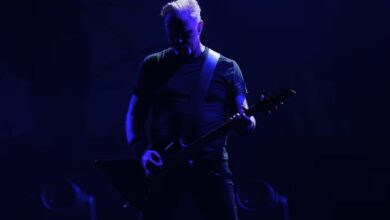AC/DC Unleashes a Firestorm: “Hells Bells” Live in Tampa Becomes the Defining Moment of the 2025 Tour
On May 16, 2025, AC/DC turned Raymond James Stadium into sacred ground as they delivered a bone-rattling performance of “Hells Bells.” As night fell over Tampa, the crowd of over 60,000 stood frozen in anticipation. Then, with a deep, echoing clang, the stadium lights dimmed and the massive bell descended slowly from above the stage. The tolling of that first bell sent shivers down every spine—it wasn’t just an intro, it was a summons.
The moment that iconic bell rang out, the atmosphere transformed into something almost ritualistic. A hush spread through the stadium, quickly followed by an eruption of cheers as the first ominous notes of the guitar riff crept in. Angus Young appeared under a single spotlight, slowly stalking the stage, his guitar tone drenched in menace. It was the kind of theatrical opening that makes your skin crawl—in the best way possible.
Brian Johnson stepped up to the mic and unleashed the opening line with ferocity. His voice was soaked in grit, but carried the same dark charisma it always had. He didn’t just sing “Hells Bells”—he summoned it. The way he hit the word “hells” was almost snarling, a warning to anyone in the audience not to underestimate what was about to happen. Every lyric that followed landed like a hammer blow.
With every strike of Phil Rudd’s snare, the track gained more weight. The band played it slower than usual, letting the tension stretch and build. It wasn’t a sprint—it was a march, and every step was deliberate. Cliff Williams’ bass rumbled like distant thunder beneath the surface, giving the song an ominous heaviness that echoed through the stadium walls and into the chest of every fan.
The stage design during “Hells Bells” was nothing short of spectacular. Fire columns erupted with every bell toll, casting flickering shadows over the band as if they were performing at the gates of the underworld. The bell itself swayed gently overhead, illuminated from below in a blood-red glow. The crowd was mesmerized—not a phone in sight, just thousands of eyes locked on the unfolding spectacle.
Angus Young took the energy even higher during the instrumental break, breaking into a haunting solo that spiraled up and down the fretboard like a cry from the abyss. His body seemed possessed by the music, twitching and spinning across the stage. It wasn’t just technique—it was pure emotion pouring from every note, casting a spell over the crowd that held until the final note faded.
As the song progressed, the crowd’s involvement deepened. Fans weren’t just watching—they were inside the song. Chanting. Screaming. Headbanging. Some had tears in their eyes, overwhelmed by the power of the moment. This wasn’t just a performance. It was a communion between the band and the audience, and “Hells Bells” was the sermon. In that moment, the lines between stage and seats vanished.
One particularly emotional scene unfolded near the front rows, where a father and son stood side by side—both wearing vintage AC/DC shirts, fists raised. You could see in their faces the generational connection this song forged. It was more than just nostalgia. It was a passing of the torch, with “Hells Bells” as the anthem that spanned time and memory.
Halfway through the song, Johnson raised his arm, and the entire stadium followed. It was a simple gesture, but it united the audience like never before. The power of live music had never felt more real, and the echo of thousands chanting the chorus in perfect unison created a wave of sound so massive it felt like it could crack the sky. Even the band seemed in awe of the moment they were shaping.
Lighting effects danced with the music, adding a cinematic edge. Strobe flashes matched every cymbal crash, while sweeping searchlights roamed the crowd, making each attendee feel like part of the show. This kind of stagecraft elevated the performance into a theatrical event, transforming the song’s ominous warning into something grand, eerie, and almost majestic.
As the final chorus roared out, flames burst once more from the stage, and the bell tolled a last, chilling time. Johnson’s voice cracked slightly as he growled the final words, giving them even more authenticity. The crowd stood stunned as the lights faded, some whispering “wow,” others simply speechless. “Hells Bells” had transcended performance—it had become a full-body experience.
Once the lights came back on, there was a brief silence before an overwhelming cheer filled the stadium. People hugged. People screamed. A group of teenagers near the stage jumped up and down like they’d just witnessed history—which they had. For many, it was the definitive live version of “Hells Bells,” one that would live in their minds forever.
Backstage reports later revealed the band had fine-tuned this version of “Hells Bells” specifically for Tampa, knowing it was one of the biggest U.S. stops of the tour. That attention to detail paid off, as fans and critics alike began posting online about how this performance eclipsed all expectations. Some even compared it to their iconic 1991 Donington set in terms of sheer power and precision.
Clips from the performance flooded social media platforms just hours later. TikToks, YouTube videos, and Instagram reels captured the bell, the flames, the screams. The visuals were powerful enough—but paired with the audio, it became clear this wasn’t just another tour stop. “Hells Bells” had become the defining moment of the night, and possibly the tour.
As fans poured out of Raymond James Stadium that night, many walked in silence, still soaking in what they had witnessed. Others couldn’t stop talking about it, replaying the moment the bell dropped or that final guitar note. One thing was certain—Tampa had just experienced something unforgettable. AC/DC had once again proven why they are legends, and “Hells Bells” rang louder than ever before.





